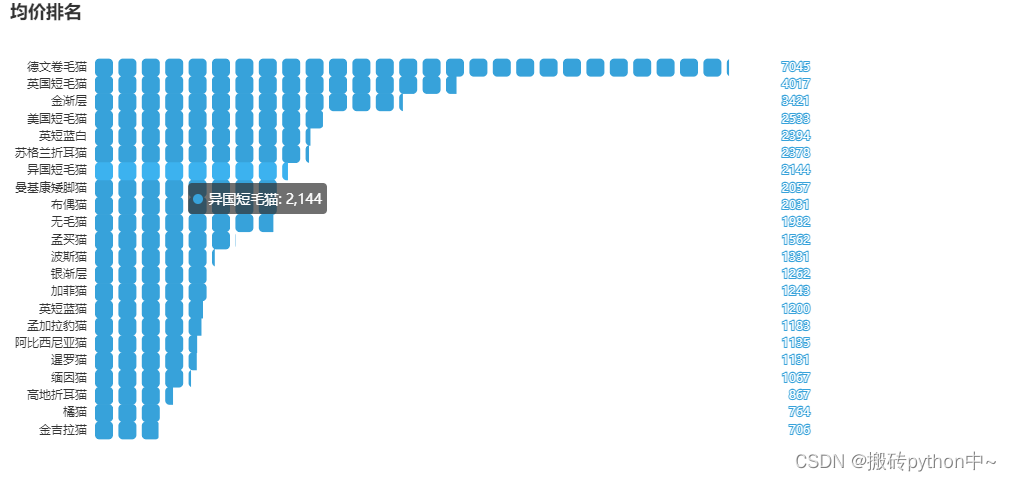-
Python采集猫咪数据并做数据可视化图
前言 😋
大家早好、午好、晚好吖~

猫咪这种生物,你经常在广大平台上刷到,在同事、朋友那里看到~
这么可爱得东西,一下就激起了你的rua毛冲动,甚至还想自己养一只

那么今天我们就来采集一下猫咪数据并做个数据可视化~~
GOGOGO!!!出发~
环境介绍:
-
python 3.6
-
pycharm
模块
采集部分使用模块:
-
csv
-
requests >>> pip install requests
数据可视化使用模块:
-
pandas
如果安装python第三方模块:
-
win + R 输入 cmd 点击确定, 输入安装命令 pip install 模块名 (pip install requests) 回车
-
在pycharm中点击Terminal(终端) 输入安装命令
+python安装包 安装教程视频
+pycharm 社区版 专业版 及 激活码免费 找助理小姐姐 V : python10010免费领
本次的案例流程思路:
一. 网站数据来源查询:

二. 代码实现步骤


采集代码
导入模块
import requests # 第三方模块 需要 pip install requests 发送请求 import parsel # 解析模块 pip install parsel import csv # 内置模块 不需要大家安装- 1
- 2
- 3
f = open('猫咪.csv', mode='a', encoding='utf-8', newline='') csv_writer = csv.DictWriter(f, fieldnames=['地区', '店名', '标题', '价格', '浏览次数', '卖家承诺', '在售只数', '年龄', '品种', '预防', '联系人', '联系方式', '异地运费', '是否纯种', '猫咪性别', '驱虫情况', '能否视频', '详情页']) # 写入表头 csv_writer.writeheader()- 1
- 2
- 3
- 4
- 5
- 6
- 7

response = requests.get(url=url, headers=headers) # 获取网页的文本数据 response.text json() 获取json字典数据 # print(response.text) # 解析数据 获取 猫咪的详情页url地址以及地区 # 1. 要把 网页文本数据转换成 parsel 解析的 对象 selector = parsel.Selector(response.text) # css选择器: 根据标签提取数据内容 href = selector.css('div.content:nth-child(1) a::attr(href)').getall() # getall() 返回的是列表 get() 是返回的字符串 areas = selector.css('div.content:nth-child(1) .area .color_333::text').getall() # 列表推导式 areas = [i.strip() for i in areas]- 1
- 2
- 3
- 4
- 5
- 6
- 7
- 8
- 9
- 10
- 11
- 12

# get() 取一个 返回是字符串 strip() 字符串的方法 title = selector_1.css('.detail_text .title::text').get().strip() # 标题 shop = selector_1.css('.dinming::text').get().strip() # 店名 price = selector_1.css('.info1 div:nth-child(1) span.red.size_24::text').get() # 价格 views = selector_1.css('.info1 div:nth-child(1) span:nth-child(4)::text').get() # 浏览次数 # replace() 替换 promise = selector_1.css('.info1 div:nth-child(2) span::text').get().replace('卖家承诺: ', '') # 浏览次数 num = selector_1.css('.info2 div:nth-child(1) div.red::text').get() # 在售只数 age = selector_1.css('.info2 div:nth-child(2) div.red::text').get() # 年龄 kind = selector_1.css('.info2 div:nth-child(3) div.red::text').get() # 品种 prevention = selector_1.css('.info2 div:nth-child(4) div.red::text').get() # 预防 person = selector_1.css('div.detail_text .user_info div:nth-child(1) .c333::text').get() # 联系人 phone = selector_1.css('div.detail_text .user_info div:nth-child(2) .c333::text').get() # 联系方式 postage = selector_1.css('div.detail_text .user_info div:nth-child(3) .c333::text').get().strip() # 包邮 purebred = selector_1.css('.xinxi_neirong div:nth-child(1) .item_neirong div:nth-child(1) .c333::text').get().strip() # 是否纯种 sex = selector_1.css('.xinxi_neirong div:nth-child(1) .item_neirong div:nth-child(4) .c333::text').get().strip() # 猫咪性别 video = selector_1.css('.xinxi_neirong div:nth-child(2) .item_neirong div:nth-child(4) .c333::text').get().strip() # 能否视频 worming = selector_1.css('.xinxi_neirong div:nth-child(2) .item_neirong div:nth-child(2) .c333::text').get().strip() # 是否驱虫 dit = { '地区': area, '店名': shop, '标题': title, '价格': price, '浏览次数': views, '卖家承诺': promise, '在售只数': num, '年龄': age, '品种': kind, '预防': prevention, '联系人': person, '联系方式': phone, '异地运费': postage, '是否纯种': purebred, '猫咪性别': sex, '驱虫情况': worming, '能否视频': video, } csv_writer.writerow(dit) print(title, area, shop, price, views, promise, num, age, kind, prevention, person, phone, postage, purebred, sex, video, worming, index_url, sep=' | ')- 1
- 2
- 3
- 4
- 5
- 6
- 7
- 8
- 9
- 10
- 11
- 12
- 13
- 14
- 15
- 16
- 17
- 18
- 19
- 20
- 21
- 22
- 23
- 24
- 25
- 26
- 27
- 28
- 29
- 30
- 31
- 32
- 33
- 34
- 35
- 36
- 37
- 38
- 39
- 40
效果



数据可视化代码
源码、解答、教程加Q裙:261823976 点击蓝字加入【python学习裙】

import pandas as pd pd.set_option('display.max_columns', None)- 1
- 2
cat_info = pd.read_csv(r'C:\Users\青灯教育\Desktop\代码\猫咪.csv', encoding='utf-8', engine='python') cat_info.head(5)- 1
- 2

from pyecharts import options as opts from pyecharts.charts import WordCloud from pyecharts.globals import SymbolType from pyecharts.globals import ThemeType words = [(i,1) for i in cat_info['品种'].unique()] c = ( WordCloud(init_opts=opts.InitOpts(theme=ThemeType.LIGHT)) .add("", words,shape=SymbolType.DIAMOND) .set_global_opts(title_opts=opts.TitleOpts(title="")) ) c.render('a.html')- 1
- 2
- 3
- 4
- 5
- 6
- 7
- 8
- 9
- 10
- 11
- 12
- 13
cat_info['地区'] = cat_info['地区'].astype(str) cat_info['province'] = cat_info['地区'].map(lambda s: s.split('/')[0]) pv = cat_info['province'].value_counts().reset_index()- 1
- 2
- 3
from pyecharts import options as opts from pyecharts.charts import Map from pyecharts.faker import Faker c = ( Map(init_opts=opts.InitOpts(theme=ThemeType.LIGHT)) .add("", [list(z) for z in zip(list(pv['index']), list(pv['province']))], "china") .set_global_opts( title_opts=opts.TitleOpts(title="猫猫售卖省份分布"), visualmap_opts=opts.VisualMapOpts(max_=16500, is_piecewise=True), ) ) c.render_notebook()- 1
- 2
- 3
- 4
- 5
- 6
- 7
- 8
- 9
- 10
- 11
- 12
- 13
- 14

# 交易品种占比树状图 from pyecharts import options as opts from pyecharts.charts import TreeMap pingzhong = cat_info['品种'].value_counts().reset_index() data = [{'value':i[1],'name':i[0]} for i in zip(list(pingzhong['index']),list(pingzhong['品种']))] c = ( TreeMap(init_opts=opts.InitOpts(theme=ThemeType.LIGHT)) .add("", data) .set_global_opts(title_opts=opts.TitleOpts(title="")) .set_series_opts(label_opts=opts.LabelOpts(position="inside")) ) c.render_notebook()- 1
- 2
- 3
- 4
- 5
- 6
- 7
- 8
- 9
- 10
- 11
- 12
- 13
- 14
- 15

# price = cat_info.groupby('品种').mean()['价格'].reset_index() price['价格'] = round(price['价格'],0) price = price.sort_values(by='价格')- 1
- 2
- 3
- 4
from pyecharts import options as opts from pyecharts.charts import PictorialBar from pyecharts.globals import SymbolType location = list(price['品种']) values = list(price['价格']) c = ( PictorialBar(init_opts=opts.InitOpts(theme=ThemeType.LIGHT)) .add_xaxis(location) .add_yaxis( "", values, label_opts=opts.LabelOpts(is_show=False), symbol_size=18, symbol_repeat="fixed", symbol_offset=[0, 0], is_symbol_clip=True, symbol=SymbolType.ROUND_RECT, ) .reversal_axis() .set_global_opts( title_opts=opts.TitleOpts(title="均价排名"), xaxis_opts=opts.AxisOpts(is_show=False), yaxis_opts=opts.AxisOpts( axistick_opts=opts.AxisTickOpts(is_show=False), axisline_opts=opts.AxisLineOpts( linestyle_opts=opts.LineStyleOpts(opacity=0), ), ), ) .set_series_opts( label_opts=opts.LabelOpts(position='insideRight') ) ) c.render_notebook()- 1
- 2
- 3
- 4
- 5
- 6
- 7
- 8
- 9
- 10
- 11
- 12
- 13
- 14
- 15
- 16
- 17
- 18
- 19
- 20
- 21
- 22
- 23
- 24
- 25
- 26
- 27
- 28
- 29
- 30
- 31
- 32
- 33
- 34
- 35
- 36
- 37
- 38

# 年龄分布,柱状图 cat_info['年龄'] = cat_info['年龄'].astype(str) age = cat_info['年龄'].map(lambda x: x.replace('个月','')).reset_index() def ages(s): if s == 'nan': return s s = int(s) if 1 <= s < 3: return '1-3个月' if 3 <= s < 6: return '3-6个月' if 6 <= s < 9: return '6-9个月' if 9 <= s < 12 : return '9-12个月' if s >= 12: return '1年以上' age['age'] = age['年龄'].map(ages) age = age['age'].value_counts().reset_index() age = age[age['index'] != 'nan']- 1
- 2
- 3
- 4
- 5
- 6
- 7
- 8
- 9
- 10
- 11
- 12
- 13
- 14
- 15
- 16
- 17
- 18
- 19
- 20

from pyecharts import options as opts from pyecharts.charts import Bar from pyecharts.faker import Faker x = ['1-3个月','3-6个月','6-9个月','9-12个月','1年以上'] y = [69343,115288,18239,4139,5] c = ( Bar(init_opts=opts.InitOpts(theme=ThemeType.LIGHT)) .add_xaxis(x) .add_yaxis('', y) .set_global_opts(title_opts=opts.TitleOpts(title="猫龄分布")) ) c.render_notebook()- 1
- 2
- 3
- 4
- 5
- 6
- 7
- 8
- 9
- 10
- 11
- 12
- 13
- 14
- 15

## 浏览次数是否跟价格成正比,散点图 view = cat_info['浏览次数'] money = cat_info['价格'] import pyecharts.options as opts from pyecharts.charts import Scatter x_data = list(view)[:1000] y_data = list(money)[:1000] c = ( Scatter(init_opts=opts.InitOpts(theme=ThemeType.LIGHT)) .add_xaxis(xaxis_data=x_data) .add_yaxis( series_name="", y_axis=y_data, symbol_size=20, label_opts=opts.LabelOpts(is_show=False), ) .set_series_opts() .set_global_opts( xaxis_opts=opts.AxisOpts( type_="value", splitline_opts=opts.SplitLineOpts(is_show=True), name='浏览次数' ), yaxis_opts=opts.AxisOpts( type_="value", axistick_opts=opts.AxisTickOpts(is_show=True), splitline_opts=opts.SplitLineOpts(is_show=True), name='价格' ), tooltip_opts=opts.TooltipOpts(is_show=False), ) ) c.render_notebook()- 1
- 2
- 3
- 4
- 5
- 6
- 7
- 8
- 9
- 10
- 11
- 12
- 13
- 14
- 15
- 16
- 17
- 18
- 19
- 20
- 21
- 22
- 23
- 24
- 25
- 26
- 27
- 28
- 29
- 30
- 31
- 32
- 33
- 34
- 35
- 36
- 37
- 38

from pyecharts import options as opts from pyecharts.charts import Boxplot v1 = [ list(a_p[a_p['age'] == '1-3个月']['价格']), list(a_p[a_p['age'] == '3-6个月']['价格']), list(a_p[a_p['age'] == '6-9个月']['价格']), list(a_p[a_p['age'] == '9-12个月']['价格']), list(a_p[a_p['age'] == '1年以上']['价格']) ] c = Boxplot(init_opts=opts.InitOpts(theme=ThemeType.LIGHT)) c.add_xaxis(["1-3个月", "3-6个月",'6-9个月','9-12个月','1年以上']) c.add_yaxis("喵喵", c.prepare_data(v1)) c.set_global_opts(title_opts=opts.TitleOpts(title="猫龄&价格")) c.render_notebook()- 1
- 2
- 3
- 4
- 5
- 6
- 7
- 8
- 9
- 10
- 11
- 12
- 13
- 14
- 15
- 16
- 17

# 价格是否与预防有关,箱型图 yufang = cat_info[['价格','预防']] yufang['预防'].unique()- 1
- 2
- 3

from pyecharts import options as opts from pyecharts.charts import Boxplot v1 = [ list(yufang[yufang['预防'] == '0针疫苗']['价格']), list(yufang[yufang['预防'] == '1针疫苗']['价格']), list(yufang[yufang['预防'] == '2针疫苗']['价格']), list(yufang[yufang['预防'] == '3针疫苗']['价格']), ] c = Boxplot(init_opts=opts.InitOpts(theme=ThemeType.LIGHT)) c.add_xaxis(["0针疫苗", "1针疫苗",'2针疫苗','3针疫苗']) c.add_yaxis("喵喵", c.prepare_data(v1)) c.set_global_opts(title_opts=opts.TitleOpts(title="防疫&价格")) c.render_notebook()- 1
- 2
- 3
- 4
- 5
- 6
- 7
- 8
- 9
- 10
- 11
- 12
- 13
- 14
- 15
- 16


尾语 💝
好了,我的这篇文章写到这里就结束啦!
有更多建议或问题可以评论区或私信我哦!一起加油努力叭(ง •_•)ง
喜欢就关注一下博主,或点赞收藏评论一下我的文章叭!!!

-
-
相关阅读:
Java进阶——Java深入学习的笔记汇总 & JVM底层、多线程、类加载 ...
iOS项目集成RN(0)
MATLAB嵌套循环
SFI立昌ML-E应用与方案
day9-操作系统初始化函数init-2
PHP8的数组-PHP8知识详解
【Docker】常用命令
荧光染料CY3/CY5/CY5.5偶联PCL纳米粒|CY3-PCL|PCL-CY5|CY5.5-PEG-PCL
R语言根据日历周期处理时间序列数据(周、月、年等):使用xts包的apply.monthly函数和mean函数计算时间序列的月平均值(monthly)
【问题处理小知识】jupyter notebook报错:500 internal server error的几种解决办法整理
- 原文地址:https://blog.csdn.net/weixin_62853513/article/details/126629941
